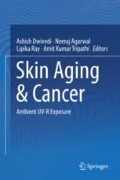Abstract
From the epidemiological point of view, it is suggested that regular contacts to UVR irradiation since our childhood are the primary cause of skin tumors. UVR-induced ROS production caused DNA damage, immune suppression, and deactivation of tumor suppression genes or overactivation of proto-oncogene. These processes are interconnected with each other. Cyclobutane pyrimidine dimers (CPDs) and (6–4) photoproducts are main key products of DNA damage. Our body system has DNA repair mechanism which mainly involves nuclear excision repair and base excision repair pathways. Defect in repair pathways and continuous accumulation of mutation lead to photocarcinogenesis. DNA lesions are an important molecular mediator in initiation of immunosuppression which has a important role in the induction of UVR-mediated skin cancer. DNA damage induced by UVR involves inhabitation of cell cycle progress or apoptosis. P53 plays an important role in cell cycle; it arrests the G1 phage and removes DNA lesion. Mutations in P53 gene come into light as an early event in the progress of UV-induced skin cancers.
Access this chapter
Tax calculation will be finalised at checkout
Purchases are for personal use only
References
Benjamin, C. L., & Ananthaswamy, H. N. (2007). p53 and the pathogenesis of skin cancer. Toxicology and Applied Pharmacology, 224(3), 241–248.
Birch-Machin, M. A., Russell, E. V., & Latimer, J. A. (2013). Mitochondrial DNA damage as a biomarker for ultraviolet radiation exposure and oxidative stress. British Journal of Dermatology, 169, 9–14.
Chaisiriwong, L., Wanitphakdeedecha, R., Sitthinamsuwan, P., Sampattavanich, S., Chatsiricharoenkul, S., Manuskiatti, W., & Panich, U. (2016). A case-control study of involvement of oxidative DNA damage and alteration of antioxidant defense system in patients with basal cell carcinoma: Modulation by tumor removal. Oxidative Medicine and Cellular Longevity, 2016, 5934024.
De Gruijl, F. R. (2008). UV-induced immunosuppression in the balance. Photochemistry and Photobiology, 84(1), 2–9.
de Laat, W. L., Jaspers, N. G., & Hoeijmakers, J. H. (1999). Molecular mechanism of nucleotide excision repair. Genes & Development, 13(7), 768–785.
Hanneman, K. K., Cooper, K. D., & Baron, E. D. (2006). Ultraviolet immunosuppression: mechanisms and consequences. Dermatologic Clinics, 24(1), 19–25.
Kripke, M. L., Cox, P. A., Alas, L. G., & Yarosh, D. B. (1992). Pyrimidine dimers in DNA initiate systemic immunosuppression in UV-irradiated mice. Proceedings of the National Academy of Sciences, 89(16), 7516–7520.
Kulms, D., Pöppelmann, B., Yarosh, D., Luger, T. A., Krutmann, J., & Schwarz, T. (1999). Nuclear and cell membrane effects contribute independently to the induction of apoptosis in human cells exposed to UVB radiation. Proceedings of the National Academy of Sciences, 96(14), 7974–7979.
Levine, A. J. (1997). p53, the cellular gatekeeper for growth and division. Cell, 88(3), 323–331.
Mueller, G., Saloga, J., Germann, T., Schuler, G., Knop, J., & Enk, A. H. (1995). IL-12 as mediator and adjuvant for the induction of contact sensitivity in vivo. The Journal of Immunology, 155(10), 4661–4668.
Nakazawa, H., English, D., Randell, P. L., Nakazawa, K., Martel, N., Armstrong, B. K., & Yamasaki, H. (1994). UV and skin cancer: Specific p53 gene mutation in normal skin as a biologically relevant exposure measurement. Proceedings of the National Academy of Sciences, 91(1), 360–364.
Rochette, P. J., Therrien, J. P., Drouin, R., Perdiz, D., Bastien, N., Drobetsky, E. A., & Sage, E. (2003). UVA-induced cyclobutane pyrimidine dimers form predominantly at thymine–thymine dipyrimidines and correlate with the mutation spectrum in rodent cells. Nucleic Acids Research, 31(11), 2786–2794.
Schuch, A. P., Moreno, N. C., Schuch, N. J., Menck, C. F. M., & Garcia, C. C. M. (2017). Sunlight damage to cellular DNA: Focus on oxidatively generated lesions. Free Radical Biology and Medicine, 107, 110–124.
Schwarz, A., Ständer, S., Berneburg, M., Böhm, M., Kulms, D., van Steeg, H., Grosse-Heitmeyer, K., Krutmann, J., & Schwarz, T. (2002). Interleukin-12 suppresses ultraviolet radiation-induced apoptosis by inducing DNA repair. Nature Cell Biology, 4(1), 26.
Schwarz, A., Noordegraaf, M., Maeda, A., Torii, K., Clausen, B. E., & Schwarz, T. (2010). Langerhans cells are required for UVR-induced immunosuppression. Journal of Investigative Dermatology, 130(5), 1419–1427.
Setlow, R. B. (1982). DNA repair, aging, and cancer. National Cancer Institute Monograph, 60, 249–255.
Sharma, P., Jha, A. B., Dubey, R. S., & Pessarakli, M. (2012). Reactive oxygen species, oxidative damage, and antioxidative defense mechanism in plants under stressful conditions. Journal of Botany, 2012.
Toews, G. B., Bergstresser, P. R., & Streilein, J. W. (1980). Epidermal Langerhans cell density determines whether contact hypersensitivity or unresponsiveness follows skin painting with DNFB. The Journal of Immunology, 124(1), 445–453.
Author information
Authors and Affiliations
Editor information
Editors and Affiliations
Rights and permissions
Copyright information
© 2019 Springer Nature Singapore Pte Ltd.
About this chapter
Cite this chapter
Singh, J. (2019). UVR-Induced Skin Cancer. In: Dwivedi, A., Agarwal, N., Ray, L., Tripathi, A. (eds) Skin Aging & Cancer. Springer, Singapore. https://doi.org/10.1007/978-981-13-2541-0_4
Download citation
DOI: https://doi.org/10.1007/978-981-13-2541-0_4
Published:
Publisher Name: Springer, Singapore
Print ISBN: 978-981-13-2540-3
Online ISBN: 978-981-13-2541-0
eBook Packages: Biomedical and Life SciencesBiomedical and Life Sciences (R0)

